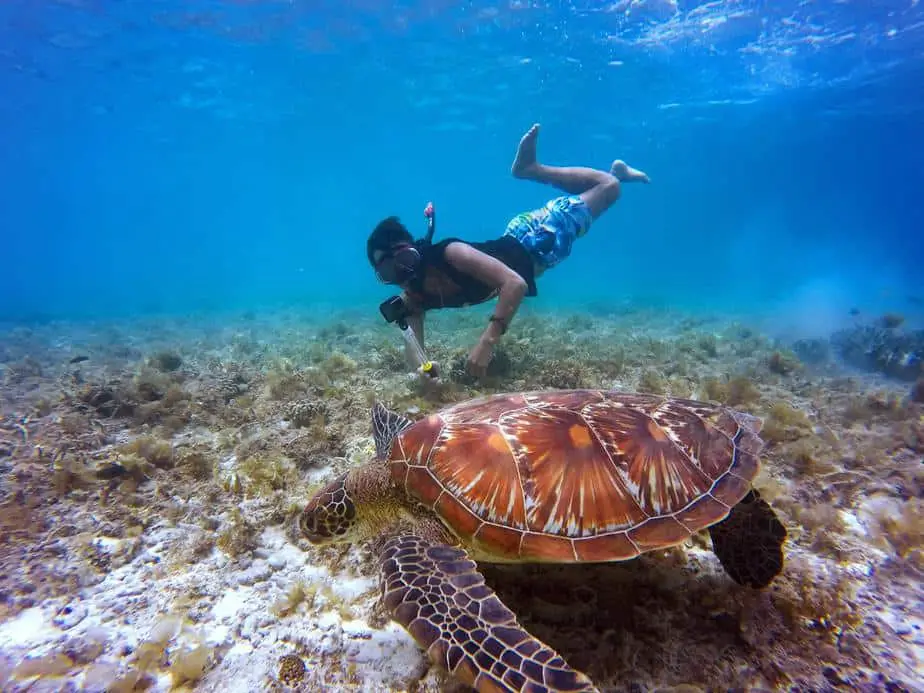Snorkeling and swimming with sea turtles in their natural habitat is an incredible experience worth doing at least once in your life, if you haven’t done it already. Few people can say that they’ve had an experience quite like that, and they make for great moments to photograph or film to show your family and friends if you have an underwater camera with you.
With that said, seeing animals in the wild can be scary and there is always a level of risk involved. That is why we want to arm you with the knowledge to keep both you and our shelled friends safe on your next snorkeling trip.
Where to Snorkel and Swim with Sea Turtles
Florida
The beautiful, aqua blue waters in Key West, Florida, is home to five of seven species of sea turtles: the Loggerhead, Green, Leatherback, Hawksbill, and Kemp’s Ridley. With a snorkel and mask equipped, you may be lucky and spot the Hawksbill and Kemp’s Ridley, which are two of the smallest species and are endangered, so people rarely ever find them.
Key West snorkeling is a great way to experience the beauty of the majestic sea turtles in a natural setting. Just make sure to observe them from afar, because they may swim away if you try to get too close. Sea turtles can speed through the ocean waters at incredible speeds, contrary to what people believe about turtles being slow.
Maui, Hawaii
Few underwater experiences in Hawaii can match snorkeling with sea turtles in Maui. The smooth, graceful movements of these creatures are so serene, it almost seems like they make time freeze. Observing them can provide snorkelers and divers with an interesting combination of excitement and relaxation.
There are many places to snorkel with sea turtles on the west side of Maui. The most popular are Mokulei’a Bay, Honolua Bay, Napili Bay, Pu’u Keka’a (Black Rock), Olowalu, and Mala Wharf. On the south side of Maui, you should head to Maluaka Beach and Nahuna for the best chance of seeing Haiwaiian Green sea turtles. You will often find them eating limu (seaweed) that collects on rocks near the shore.
Keep all of this in mind the next time you snorkel in Hawaii.
The Caribbean
Costa Rica
You can find four of the seven species of sea turtles in Costa Rica: the Hawksbill, Olive Ridley, Leatherback, and Green sea turtles. You can find Olive Ridley turtles year round along the Pacific coast of Costa Rica, but the best months are September and October. The best locations are Santa Rosa National Park and Ostional Wildlife Refuge.
Next, you can find Hawksbills along the Caribbean coast of Costa Rica from March to October. You can head over to Cahuita National Park, Tortuguero National Park, or Gandoca-Manzanillo Wildlife Refuge to see them nesting and hatching.
Did you know that most of the Green sea turtles in the Caribbean were originally born on a handful of beaches in Tortuguero? This is likely owing to the fact that the Sea Turtle Conservancy is located here. You will generally find Green sea turtles nest and hatch from June through October. Visitors are only allowed to see the females lay their eggs if they are on a tour with an officially registered guide; tours take place at night after 8PM.
Finally, you may be able to see large Leatherback turtles nesting between the months of March and May, and by the Pacific coast from September and March. Despite their large size, they are a vulnerable species and seeing one is rare even during peak season. A few locations to see them are the Gandoca-Manzanillo Wildlife Refuge and Tortuguero National Park.
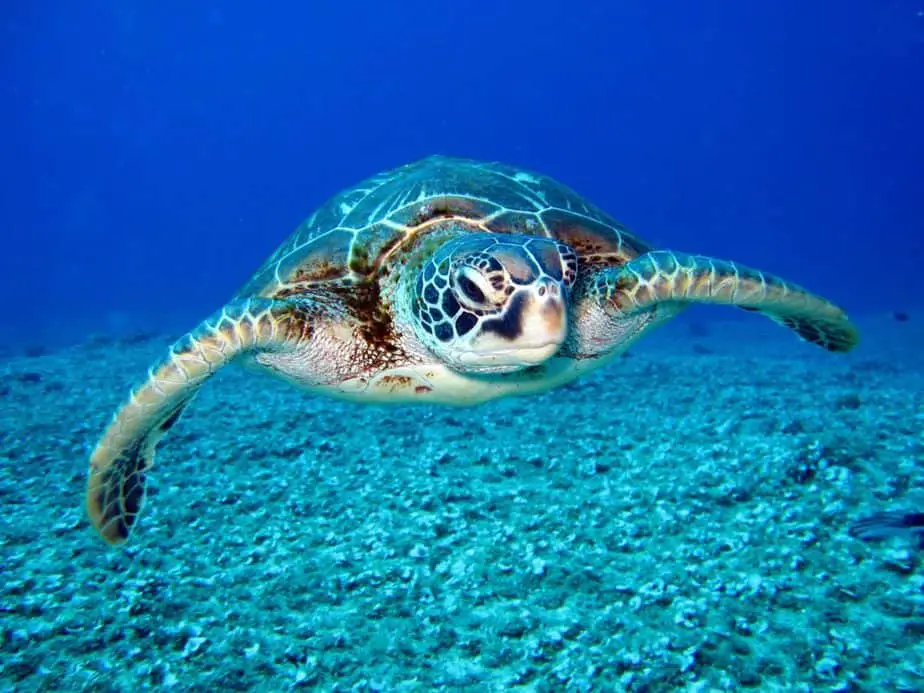
Jamaica
Off the coast of Jamaica you can find the Hawksbill turtle and Green turtle in the waters. Specifically, turtles tend to nest on the north coast around Montego Bay, Ocho Rios, and Kingston Harbour’s Palisadoes Spit.
The eggs will hatch between May and December, and turtle enthusiasts may be interested to know that in late September there is a “Beach Clean-Up Day” that typically attracts thousands of volunteers and this is a great chance to see some baby turtles.
Mexico
The Yucatan Peninsula (Riviera Maya) in Mexico is home to six out of seven sea turtle species. Along the many thousands of miles of coastline, turtles come to nest each season. The first of the two areas you should keep in mind are the Riviera Maya-Cancun Coast where numerous nesting beaches can be found: Akumal Bay, Sian Ka-an Biosphere Reserve, and X’Cacel Beach.
It is there that visitors can hope to find the Hawksbill, Loggerhead, and Green turtles. In the Pacific coast you can find the Olive Ridley, Leatherback, and Green Turtles, and the Kemp’s Ridley can be found in the Gulf of Mexico.
Belize
In the warm, clear waters of Belize you can find the Hawksbill, Loggerhead, and Green turtles. These majestic creatures will often be found near the barrier reefs and coasts that are abundant in sponges, marine algae, and jellyfish.
Thailand
There are no guarantees that you will find marine life everytime you snorkel, but in Thailand the chances are pretty high for you to see sea turtles. The two sea turtles that you’ll see the most are the Hawksbill turtle and the Green sea turtle. They can be found at the Similan Islands, Phi Phi Islands, and Surin Islands.
A Hawksbill turtle has a vibrantly colored carapace, though they tend to be a bit smaller. Furthermore, their shell has a sharp, serrated edge and their head is more pronounced and narrower. Their hawk like bill is the reason why they have the name they have, and they use it to eat mostly sponges.
Next, Green turtles have a diet consisting mostly of seagrass. Despite their name, they do not have a green shell; rather it is mostly shades of brown. Their name comes from their green meat fat, which is most likely this way due to their seagrass diet.
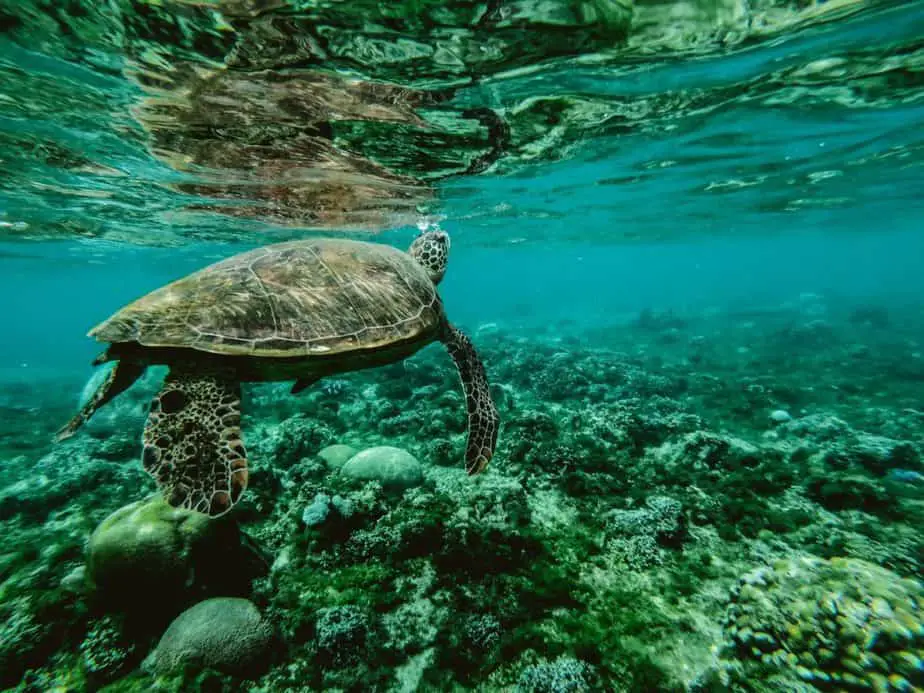
Indonesia
Indonesia is home to six out of seven species of sea turtles. One of the best places to see Hawksbill and Green sea turtles is Turtle Traffic off the coast of Maratua Island. As the name suggests, you can find lots of sea turtles at Turtle Traffic. Some visitors have found as many as 50 turtles in the span of two hours, which is unprecedented anywhere else.
You can also swim with sea turtles at Derawan, Sangalaki and the three Gili islands: Gili Meno, Gili Air and Gili Trawangan. The turtles found by the coast of these islands are very accustomed to human presence, allowing them to be approached and observed. That doesn’t mean you should go ahead and touch them, but it’s a lot easier if you wanted to take a selfie with a sea turtle.
Some well-known places where you can see a lot of sea turtles while diving are Bunaken National Park, Lekuan, Fukui, and Muka Kampung. At these sites, visitors can find turtles feeding on sponges and soft corals, lounging by the ledges, swimming by blissfully tolerant of nearby divers. Thanks to conservation efforts, the sea turtle population has increased in Indonesia and turtles rarely see humans as a threat.
Malaysia
We recommend checking out Sipadan Island in Malaysia to get your sea turtle fix satisfied. You can dive, swim, and snorkel with Green and Hawksbill turtles in this small island in the Celebes Sea, near Sabah’s southeast coast. Tourists can expect to see a large number of turtles everyday; with a guide, seeing over a dozen or two dozen turtles in one session is not unusual.
Especially during low tide, when the green turtles that like to munch on the seagrass beds visit the reef to lounge around. Sometimes you can even witness the sea turtles mating which is quite a spectacle. Groups of males chase after a female in a frenzy to see who can mate with her first. Sipadan is a fantastic location to swim with sea turtles and potentially witness some extraordinary sights during mating season.
The Philippines
The Philippines is home to five sea turtle species: the Hawksbill, Leatherback, Loggerhead, Green, and Olive Ridley turtle. There are various places in the Philippines where you can find them, such as Apo Island, Pescador Island, Balicasag Island, Mantigue Island, Helicopter Island, and of course Turtle Bay.
From the months of October to March, hordes of Hawksbill and Green sea turtles will arrive to nest at four locations within Turtle Bay. Thanks to the hard work of Secret Paradise Resort, many sea turtles have been protected and that is why they return each year to their safe haven.
The best time to swim with sea turtles in the Philippines is in the morning when they are feeding. Just leisurely snorkel around while keeping an eye on the seabed to spot some. Within ten to fifteen minutes of snorkeling, you can most likely encounter a few turtles. Keep in mind they are shy and will avoid you if you get too close.
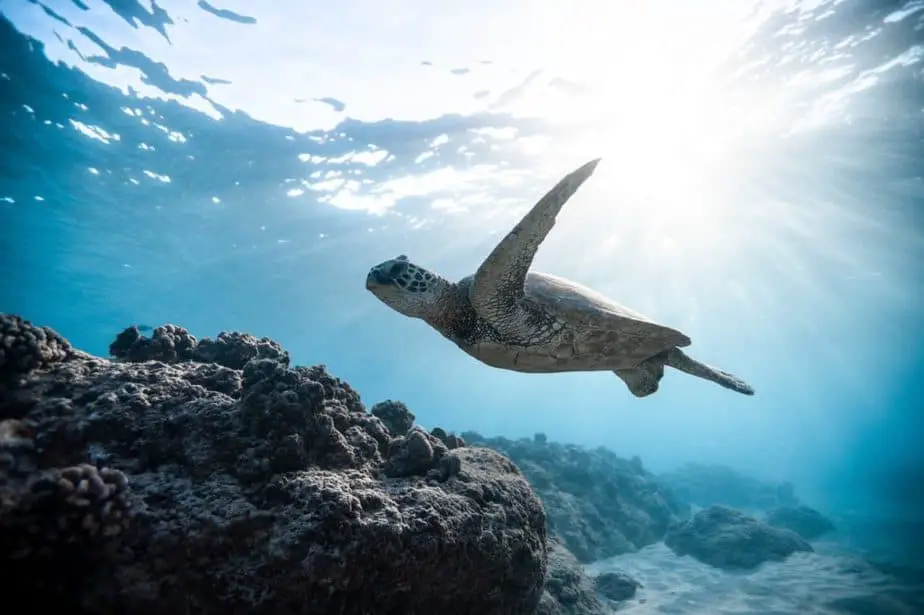
How to Snorkel with Sea Turtles
If you’re lucky enough to find a sea turtle (or perhaps a curious sea turtle will find you), make sure to observe them at a safe distance. Do not reach out to grab them, do not try to chase them, and definitely do not try to ride one.
Most of the time, the sea turtle will swim away. The water is their home turf, and they can reach speeds of 25 miles per hour, so good luck trying to catch it. If it feels cornered, turtles can bite you. Additionally, sea turtles are an endangered species protected by law, and you should stay at least 5-10 feet away at all times.
As much as you want to swim next to a sea turtle, you must keep your distance for not just your safety, but because you can get fined heavily.
Going on a Guided Tour
If you’re not an experienced snorkeler or want to increase your chances of swimming and snorkeling with sea turtles, we recommend you go on a guided tour. Most species of sea turtles are endangered and are federally protected by law. If you are lucky enough to find one, you might not know that interacting with one may be illegal and can get you a hefty fine.
By going to see them with a tour guide, you can get access to the best locations without having to do extensive research by yourself. Furthermore, the tour guide will have a license allowing them to do these you can’t, such as use a flashlight. This is important since some sea turtle activities can only be witnessed at night.
The tour guide will also give you valuable information that only locals would be privy to. In other words, if you want a hands-off, relaxing, and laid back experience, we recommend you hire a tour guide.
Threats to Sea Turtles
Most species of sea turtles are endangered and that is why there are laws protecting them. The biggest danger to sea turtles are negligent human behavior. Common causes of death for sea turtles are due to getting struck by boat propellers, caught in fishnets, pollution, and illegal poaching.
In addition, coastal development is destroying nesting grounds and climate change is believed to be causing females to birth more females. The gender of a hatchling is influenced by the temperature during their gestation period, with warmer temperatures producing females and cooler temperatures males. Warmer sands may contribute to quicker gestation periods and female births at unprecedented rates.
Plastic waste can get caught around a turtle’s neck or flippers which can cause them to drown. They sometimes mistake floating plastic bags as jellyfish and when they try to swallow their “food”, end up choking and suffocating. As an aside, please do not discard single-use plastic waste into the ocean because you could be contributing to the endangerment of sea turtles.
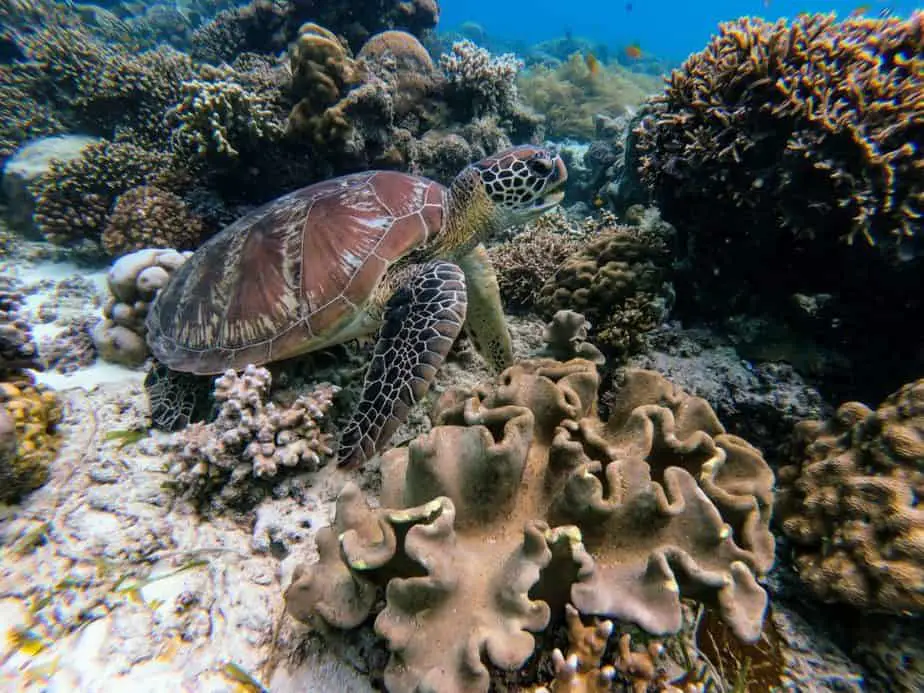
Are Sea Turtles Dangerous?
While most species of sea turtles are endangered, and it can be easily argued that humans pose more of a threat to them than they do to us, any wild animal has the potential to hurt us. Sea turtles almost never attack humans, even when they are provoked. But if they do, they will try to bite you, and it can be really painful.
Sea turtles have powerful jaws and sharp beaks. They can cause bruises, cuts, and even break bones. However, it depends on how threatened the sea turtle feels. Since there are many species of sea turtles, each differing in size and temperament, we cannot make a general statement on whether they are dangerous or not.
With that said, err on the side of caution and observe them from a distance. Leave them well alone and don’t try to touch them (more on that below). For the most part, sea turtles are shy and will avoid swimmers, snorkelers and divers.
Wear A Wetsuit when Snorkeling with Sea Turtles
Even though it is unlikely a sea turtle will attack you, if they do then having an extra layer of protection is helpful. However, that’s not all it can protect you from. Sea turtles love to eat jellyfish as part of their diet. After a jellyfish has been eaten, sometimes its stinger will be left floating in the water.
If you happen to swim by it, you can get stung by it and get paralyzed just the same as if a live jellyfish had stung you. That is why you should wear extra protection, such as a full snorkeling wetsuit or rashguard. Furthermore, you should also be wearing some kind of buoyancy aid, preferably a life vest, waterski belt or snorkel vest in case you do get stung.
Don’t Feed Sea Turtles
Sometimes you might be causing more harm than good, and feeding sea turtles human food like chopped up chicken, fish, dog food, bread, or hot dogs can cause unforeseen long-term problems.
The sea turtles that regularly eat the foods that humans feed them end up growing extremely big – three times larger than normal – compared to sea turtles that haven’t been fed human food. And while this seems like a good thing, it actually exposes the turtles to some health conditions such as cardiovascular issues or liver disease.
Furthermore, research has been on sea turtle behavior, and it was found that turtles that have been fed are more likely to be hit and killed by a boat. They have been trained to surface and seek out humans for food. Due to their large size, surfacing makes them susceptible to getting hit by boats, and it is also possible that humans with malicious intentions may harm them.
It is recommended that humans should leave turtles well alone. Do not touch them, do not feed them, let them live and feed in their natural habitat while you observe at a distance.
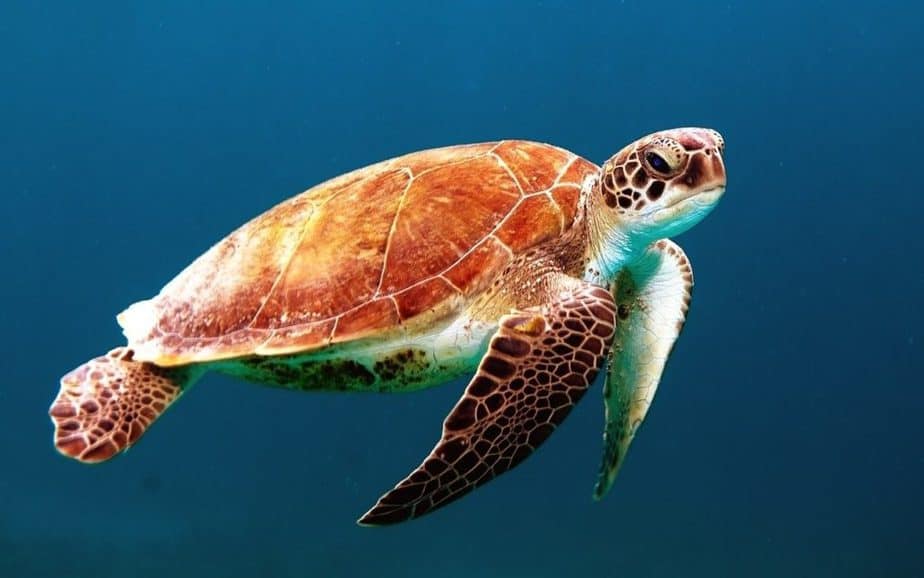
Don’t Touch Them
Just to reiterate, do NOT touch any sea turtles that you find. Not only is it potentially dangerous, it is ILLEGAL. Don’t chase them, touch them, ride them, harass them, or harm them. They are protected by law and you can be fined heavily. Put yourself in the turtle’s position. If some stranger came up to you and started touching you, you’d be pretty angry and/or scared wouldn’t you?
Stay Calm
The best way to observe any marine life is to stay calm and not to do any sudden movements. Perfect, that is exactly what snorkeling is! The more you try to chase turtles, the higher the chance they will swim away from you. By staying very still, turtles will feel calm and possibly allow you to keep observing them at a distance. Sometimes they may even approach you if they are curious.
Interesting Sea Turtle Facts
Did you know that:
- There are only seven species of sea turtle, and though they are now all endangered, they have been around since the age of dinosaurs.
- Sea turtles are reptiles; they have scaly skin, are cold blooded, breathe air (i.e. they don’t have gills like fish) and lay eggs on land.
- Sea turtles will lay their eggs on the beach. Unfortunately, these eggs are often eaten by predators or damaged by humans. If the eggs are lucky enough to hatch, the baby turtles must make the dangerous trek from land to water without being eaten by predators. Then they must reach adulthood where they have few natural predators. Talk about a rough childhood.
- Sea turtles have a life span of approximately 80 years.
- After hatching, male sea turtles never return to land, but females will return to the beach they were born to lay eggs. As such, when you snorkel and swim with sea turtles, they will almost always be a female.
- Sea turtles prefer to live in temperate and warm waters, and can migrate thousands of miles across oceans to warmer water.
- Sea turtles can reduce their heart rate to minimize oxygen use, allowing them to stay underwater as long as 5 hours at a time (remember, turtles have lungs and breathe air like us!). However, when they are feeding they use up lots of oxygen and must resurface every few minutes.
- Unlike tortoises and land turtles, sea turtles cannot fully retract their body into their shells.
- Sea turtles use their rear flippers for steering, and their front flippers for propulsion.
- Sea turtles eat a diet consisting of sponges, algae, shrimps, sea grass, crabs, mollusks, and jellyfish.
- Sea turtles can take anywhere from 10-50 years to reach sexual maturity depending on the species.
- Females will lay up to 150 eggs every few years, however the mortality rate for baby sea turtles is incredibly high. It is estimated that out of one thousand hatchlings, only one will survive long enough to reach a breeding age.
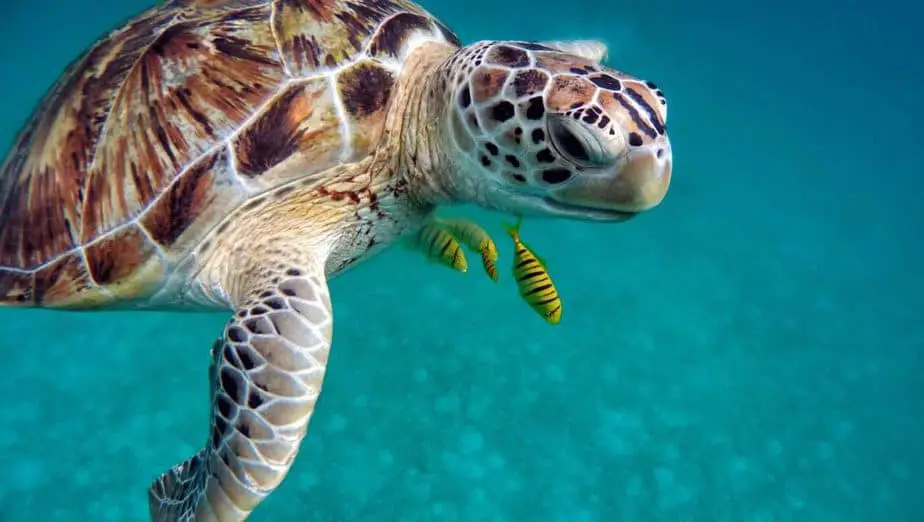
Swimming with Sea Turtles – Recap
There are many places in the world where you can snorkel and swim with sea turtles, and in this guide we’ve covered only some of them. Wherever you decide to go, there are a few things that you should keep in mind that are always applicable.
First, you should probably hire a tour guide and make any bookings in advance. You can try to find them on your own, but using the expertise of a local expert will make things a lot smoother. Plus, some places are only accessible on a tour anyways or with reservations made in advance, so you need to do your research.
Second, remember that most sea turtle species are endangered, and there are probably some strict laws in place that protect them. Furthermore, you should never attempt to touch them. Sea turtles can bite, and they may attack you if they feel threatened. You may also get fined for not keeping a safe distance, so stay at least 5-10 feet away (if the turtles even allow you to get so close).
Lastly, consider wearing a full wetsuit if there are lots of jellyfish nearby. Turtles like to feed on jellyfish and sometimes the jellyfish stingers will be floating around in the water near turtles. They can still sting you and lead to paralysis, and wearing some extra protection can prevent this from happening.
Sea turtles are majestic creatures, from the lumbering Loggerhead to the smaller Hawksbill, each species is a sight to behold. So if you see while snorkeling, make sure you have your camera on hand so that you can take some nice underwater pictures to remember your vacation by.

